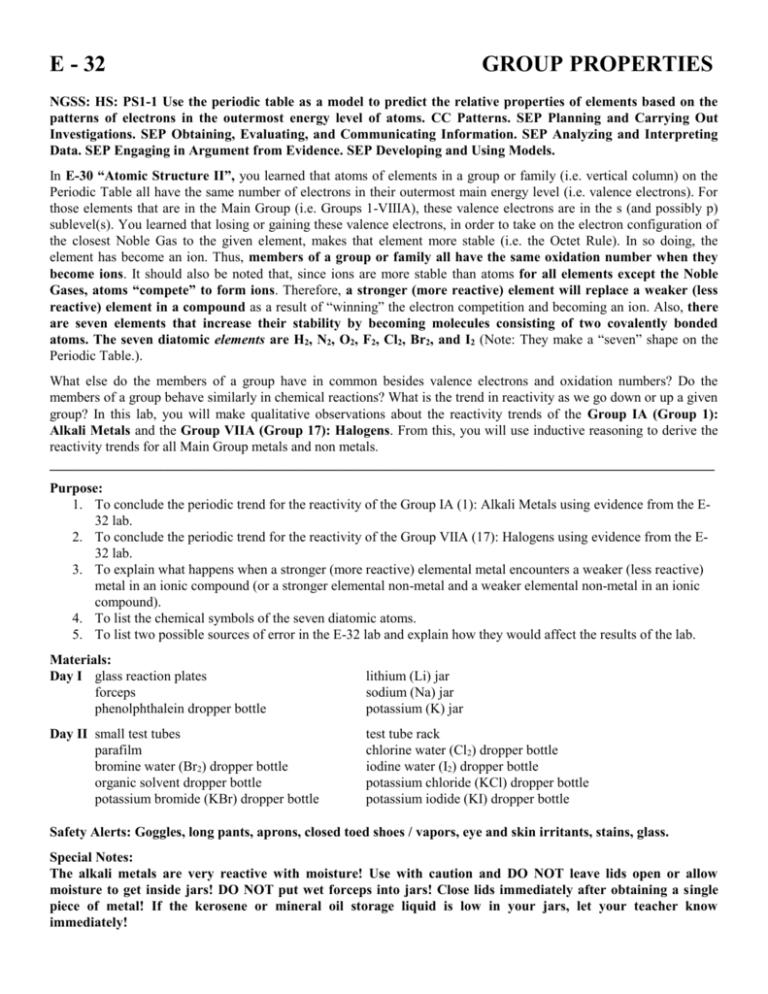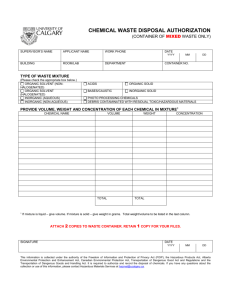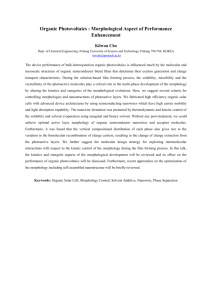E-32-14 ls - Moline High School
advertisement

E - 32 GROUP PROPERTIES NGSS: HS: PS1-1 Use the periodic table as a model to predict the relative properties of elements based on the patterns of electrons in the outermost energy level of atoms. CC Patterns. SEP Planning and Carrying Out Investigations. SEP Obtaining, Evaluating, and Communicating Information. SEP Analyzing and Interpreting Data. SEP Engaging in Argument from Evidence. SEP Developing and Using Models. In E-30 “Atomic Structure II”, you learned that atoms of elements in a group or family (i.e. vertical column) on the Periodic Table all have the same number of electrons in their outermost main energy level (i.e. valence electrons). For those elements that are in the Main Group (i.e. Groups 1-VIIIA), these valence electrons are in the s (and possibly p) sublevel(s). You learned that losing or gaining these valence electrons, in order to take on the electron configuration of the closest Noble Gas to the given element, makes that element more stable (i.e. the Octet Rule). In so doing, the element has become an ion. Thus, members of a group or family all have the same oxidation number when they become ions. It should also be noted that, since ions are more stable than atoms for all elements except the Noble Gases, atoms “compete” to form ions. Therefore, a stronger (more reactive) element will replace a weaker (less reactive) element in a compound as a result of “winning” the electron competition and becoming an ion. Also, there are seven elements that increase their stability by becoming molecules consisting of two covalently bonded atoms. The seven diatomic elements are H2, N2, O2, F2, Cl2, Br2, and I2 (Note: They make a “seven” shape on the Periodic Table.). What else do the members of a group have in common besides valence electrons and oxidation numbers? Do the members of a group behave similarly in chemical reactions? What is the trend in reactivity as we go down or up a given group? In this lab, you will make qualitative observations about the reactivity trends of the Group IA (Group 1): Alkali Metals and the Group VIIA (Group 17): Halogens. From this, you will use inductive reasoning to derive the reactivity trends for all Main Group metals and non metals. ________________________________________________________________________________________________ Purpose: 1. To conclude the periodic trend for the reactivity of the Group IA (1): Alkali Metals using evidence from the E32 lab. 2. To conclude the periodic trend for the reactivity of the Group VIIA (17): Halogens using evidence from the E32 lab. 3. To explain what happens when a stronger (more reactive) elemental metal encounters a weaker (less reactive) metal in an ionic compound (or a stronger elemental non-metal and a weaker elemental non-metal in an ionic compound). 4. To list the chemical symbols of the seven diatomic atoms. 5. To list two possible sources of error in the E-32 lab and explain how they would affect the results of the lab. Materials: Day I glass reaction plates forceps phenolphthalein dropper bottle lithium (Li) jar sodium (Na) jar potassium (K) jar Day II small test tubes parafilm bromine water (Br2) dropper bottle organic solvent dropper bottle potassium bromide (KBr) dropper bottle test tube rack chlorine water (Cl2) dropper bottle iodine water (I2) dropper bottle potassium chloride (KCl) dropper bottle potassium iodide (KI) dropper bottle Safety Alerts: Goggles, long pants, aprons, closed toed shoes / vapors, eye and skin irritants, stains, glass. Special Notes: The alkali metals are very reactive with moisture! Use with caution and DO NOT leave lids open or allow moisture to get inside jars! DO NOT put wet forceps into jars! Close lids immediately after obtaining a single piece of metal! If the kerosene or mineral oil storage liquid is low in your jars, let your teacher know immediately! Molecular halogens are toxic and should not be inhaled! Use halogens in a well ventilated area! Some people may experience eye or skin irritation after exposure to halogens. If this happens to you, let your teacher know immediately! Also, if you have a known allergy to chlorine or iodine, let your teacher know before proceeding with this lab! Procedure: Note: This may be done as a demonstration by your teacher. Day 1 - the Reaction between Alkali Metals and Water (i.e. HOH) 1. Obtain three glass reaction plates and one forceps. Make sure they are clean and dry. Set them at your workstation. 2. Put approximately 25 mL of distilled water in each reaction plate. Add three drops of phenolphthalein to each reaction plate. 3. Making sure you are wearing your goggles, carefully open the lithium (Li) jar and remove one piece of lithium with your clean, dry forceps. Close the lid immediately. 4. Drop your piece of lithium (Li) into your first glass reaction plate. Record your observations in your data table. Be sure to note the color of the water! 5. Repeat steps 3 and 4 with sodium (Na). Make sure to record your results in your data table. Make sure to note which reaction was more vigorous, Li + HOH or Na + HOH. 6. Repeat steps 3 and 4 with potassium (K). Make sure to record your results in your data table. Make sure to note which reaction was more vigorous, Li + HOH, Na + HOH, or K + HOH. 7. Make sure to clean up your workspace and put all materials away. 8. Use your black textbook to look up what phenolphthalein indicates at its various colors. Record your findings in your data table. Day 2 - the Reaction between Free Halogens and Halide Ions Note: This may be done as a demonstration by your teacher. Control Group 1. Obtain a test tube rack and 12 small test tubes. Make sure the test tubes are clean and as dry as possible. Set them at your workstation. 2. To one test tube, add 15 drops of chlorine water (Cl2) and 15 drops of organic solvent from the appropriate dropper bottles. Place a small piece of parafilm over the test tube and shake to mix. Record the color in the organic solvent layer in your data table. 3. To a second test tube, repeat step 2 with bromine water (Br2) and organic solvent. Record the color in the organic solvent layer in your data table. 4. To a third test tube, repeat step 2 iodine water (I2) and organic solvent. Record the color in the organic solvent layer in your data table. 5. Set these three test tubes aside in one area of your test tube rack for later reference. Experimental Group 6. To one test tube, add 15 drops of chlorine water (Cl 2), 15 drops of organic solvent, and 15 drops of potassium chloride (KCl) from the appropriate dropper bottles. Place a small piece of parafilm over the test tube and shake to mix. Record the color in the organic solvent layer (i.e. the “oily bubble layer”) in your data table. 7. Repeat step 6 with each of the following combinations: Cl2 , organic solvent, and KBr Cl2 , organic solvent, and KI Br2 , organic solvent, and KCl Br2 , organic solvent, and KBr Br2 , organic solvent, and KI I2 , organic solvent, and KCl I2 , organic solvent, and KBr I2 , organic solvent, and KI Make sure to record the color in the organic solvent layer for each test tube in your data table. Be careful to keep track of which test tube is which!!! 8. Use soap and water to clean out your test tubes. Then, make sure to clean up your workspace and put all materials away. Data Table: DAY ONE: Observations Solution color Degree of reactivity (i.e. high, medium, or low) Li + HOH Na + HOH K + HOH Phenolphthalein indicates an _____________________ when _________________ in color and a ____________________ when ___________________ in color. DAY TWO: CONTROL GROUP Color of organic layer Cl2 Br2 I2 EXPERIMENTAL TRIALS KCl (Color of organic layer) KBr (Color of organic layer) KI (Color of organic layer) Cl2 Br2 I2 ** Place a star in the boxes in which the color of the solution has changed from the original color (refer to the control group). Analysis: for Day 1 - the Reaction between Alkali Metals and Water (HOH) 1. Write balanced equations for the three reactions for Day 1. To do this, first, use your knowledge of the purpose of phenolphthalein to determine the first product. The second product is a gas. Once you have the two products for each of the three reactions written with correct subscripts, balance the equation with coefficients. 2. Write a reactivity series for the three alkali metals you used using a greater than symbol between each metal _____ _____ _____ . (Hint: Which metal gave the biggest spark in water?). for Day 2 - the Reaction between Free Halogens and Halide Ions 3. Write equations for the nine reactions for Day 2. For the three reactions that actually worked, write the correct products (Hint: One will be an element and one will be a compound.) and then balance those equations with coefficients. For the six reactions that DID NOT work, recopy the reactant side of the equation followed by the letters NR (i.e. no reaction). 4. Write a reactivity series for the three halogens you used using a greater than symbol between each non-metal _____ _____ _____ . (Hint: You must first decide which three of the nine reactions worked. To do this, compare the expected color (See your control group data!) in the organic layer to the actual color (See your experimental group data!). If they are NOT the same, it reacted. For example, if Cl2 was added to the first reaction, what color should be in the organic layer? Was it? Was there a reaction? Then, rank the three halogens by remembering that a stronger element will replace a weaker element in a compound.). Questions: 1. Because the Alkali Metals react with moisture, how must they be stored? 2. Fill in the blanks: Phenolphthalein indicates a(n) __________ when __________ in color and a __________ when __________ in color. 3. In the reactions between the Alkali Metals and water, which product did phenolphthalein help you to discover. How (Hint: Look up the Arrhenhius definition of a base.)? 4. Given the elements present in the reactions between the Alkali Metals and water, what possible gases could be given off? What test could be used to confirm the correct gas’ identity? What tests could be done to eliminate other gases (Hint: How could you make use of an inverted beaker and a wood splint?)? 5. When an Alkali Metal becomes an ion, does it gain or lose an electron? 6. Of the Alkali metals you used, which was the strongest (most reactive)? the weakest (least reactive)? 7. Given the reaction, F2 + KCl, will a reaction occur? If so, write a balanced equation for it. 8. Which two Alkali Metals are vital minerals for human nutrition (Hint: Use a Biology book and look under minerals.)? 9. What color are the three Halogens you studied in water? 10. Where was the organic layer compared to the water layer in the reactions of the Halogens with the Halides? Why (Hint: What do we know about objects that float/sink in water?)? 11. When a Halogen (non-metal) becomes an ion, does it gain or lose an electron? 12. Of the Halogens you used, which was the strongest (most reactive)? the weakest (least reactive)? 13. Which three Halogens are vital minerals for human nutrition (Hint: Use a Biology book and look under minerals.)? 14. Fill in the blanks: A __________ element will replace a __________ element in a compound. 15. Name the seven diatomic elements. Conclusion: Mind Prober: 1. Using the Alkali Metals and the Halogens (non-metals) as a guide, where would you expect to find the strongest (most reactive) Main Group metals? Non-metals? 2. Predict what would happen in each of the following reactions: a. Ba + MgCl2 b. Ca + SrCl2 c. Na2S + O2 d. Na2Se +S




